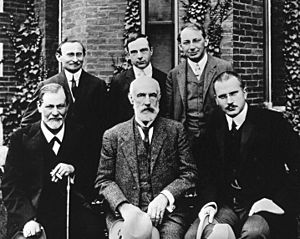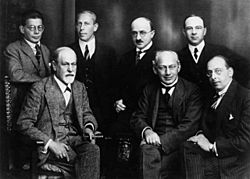Sándor Ferenczi facts for kids
Quick facts for kids
Sándor Ferenczi
|
|
|---|---|
 |
|
| Born |
Sándor Fränkel
7 July 1873 |
| Died | 22 May 1933 (aged 59) |
| Known for | Budapest School of Psychoanalysis, identification with the aggressor, regressus ad uterum |
| Scientific career | |
| Fields | Psychoanalysis |
| Institutions | International Psychoanalytical Association (president) Hungarian Psychoanalytical Society (founder) |
| Influences | Sigmund Freud |
| Influenced | Mihály Bálint, Alice Bálint, Imre Hermann, Sigmund Freud, Otto Rank, Mária Török, Nicolas Abraham, Melanie Klein |
Sándor Ferenczi (7 July 1873 – 22 May 1933) was a Hungarian psychoanalyst, a key theorist of the psychoanalytic school and a close associate of Sigmund Freud.
Contents
Biography

Born Sándor Fränkel to Baruch Fränkel and Rosa Eibenschütz, both Polish Jews, he later magyarized his surname to Ferenczi.
He was notable as a psychoanalyst for working with the most difficult of patients and for developing a theory of more active intervention than is usual for psychoanalytic practice. During the early 1920s, criticizing Freud's "classical" method of neutral interpretation, Ferenczi collaborated with Otto Rank to create a "here-and-now" psychotherapy that, through Rank's personal influence, led the American Carl Rogers to conceptualize person-centered therapy.
Ferenczi has found some favour in modern times among the followers of Jacques Lacan as well as among relational psychoanalysts in the United States. Relational analysts read Ferenczi as anticipating their own clinical emphasis on mutuality (intimacy), intersubjectivity, and the importance of the analyst's countertransference. Ferenczi's work has strongly influenced theory and praxis of the interpersonal-relational theory of American psychoanalysis, as typified by psychoanalysts at the William Alanson White Institute.
Ferenczi was president of the International Psychoanalytical Association from 1918 to 1919.
Ernest Jones, a biographer of Freud, termed Ferenczi as "mentally ill" at the end of his life, famously ignoring Ferenczi's struggle with pernicious anemia, which he died from in 1933. Though desperately ill with the then-untreatable disease, Ferenczi managed to deliver his most famous paper, "Confusion of Tongues" to the 12th International Psycho-Analytic Congress in Wiesbaden, Germany, on 4 September 1932.
Ferenczi's reputation was revived in 2002 by publication of Disappearing and Reviving: Sandor Ferenczi in the History of Psychoanalysis. One of the book's chapters dealt with the nature of the relationship between Freud and Ferenczi.
Ferenczi's main ideas
Activity in psychoanalytic therapy
Contrary to Freud's opinion of therapeutic abstinence, Ferenczi advocated a more active role for the analyst. For example, instead of the relative "passivity" of a listening analyst encouraging the patient to freely associate, Ferenczi used to curtail certain responses, verbal and non-verbal alike, on the part of the analysand so as to allow suppressed thoughts and feelings to emerge. described in a case study how he used a kind of behavioral activation (uncommon in the psychoanalytic therapy at that time) when he asked an opera singer with performance anxiety to “perform” during a therapy session and in this way to struggle with her fears.
Clinical empathy in psychoanalysis
Ferenczi believed the empathic response during therapy was the basis of clinical interaction. He based his intervention on responding to the subjective experience of the analysand. If the more traditional opinion was that the analyst had the role of a physician, administering a treatment to the patient based upon diagnostic judgment of psychopathology, Ferenczi wanted the analysand to become a co-participant in an encounter created by the therapeutic dyad. This emphasis on empathic reciprocity during the therapeutic encounter was an important contribution to the evolution of psychoanalysis. Ferenczi also believed that self-disclosure of the analyst is an important therapeutic reparative force. The practice of including the therapist's personality in therapy resulted in the development of the idea of mutual encounter: the therapist is allowed to discuss some content from his/her own life and thoughts, as long as it is relevant to the therapy. This is in contrast to the Freudian therapeutic abstinence according to which the therapist should not involve his/her personal life with the therapy, and should remain neutral. The mutual encounter is a precedent for the psychoanalytic theory of two-person psychology.
The "confusion of tongues" theory of trauma
Ferenczi believed that the persistent traumatic effect of chronic overstimulation, deprivation, or empathic failure (a term further elaborated by Heinz Kohut) during childhood is what causes neurotic, character, borderline and psychotic disorders. The confusion of tongues occurs when the child pretends to be the spouse of the parent.
A Lacanian reading of Ferenczi's 'Confusion of Tongues' was published in 2018 by Miguel Gutiérrez-Peláez. Raluca Soreanu has investigated the metapsychological implications of 'Confusion of Tongues' the Clinical Diary for a theory of psychic splitting.

See also
 In Spanish: Sándor Ferenczi para niños
In Spanish: Sándor Ferenczi para niños
- Amphimixis
- Identification with the aggressor
- Little Arpad
- Otto Rank

